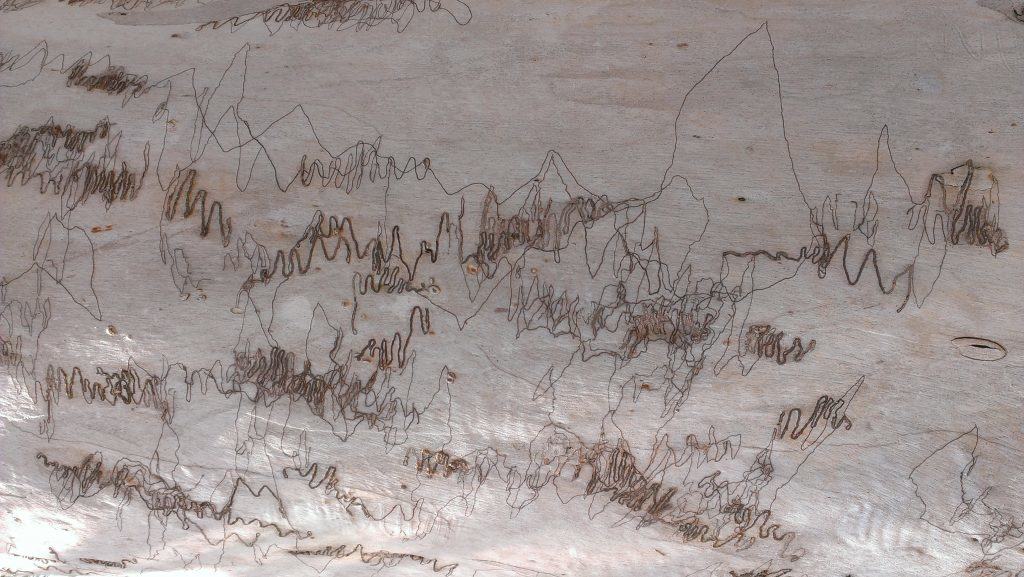Continuing on from one of my last posts…
You see the photo above? That is the trunk of the aptly named “scribbly gum”. It’s a fairly common Eucalyptus tree, found all over Australia, and this name refers several different species: Eucalyptus haemastoma, Eucalyptus sclerophylla, Eucalyptus haemastoma, Eucalyptus racemosa, Eucalyptus signata and Eucalyptus rossii.
[keep in mind that I have turned the photo 90 degrees, from a portrait to a landscape view, so that it fits better in with the blog format, it’s normally like
These marks are caused by little scribbly gum moth larvae (Ogmograptis scribula). Right. Okay, so we know what ’causes’ the scribbles. Or do we?
No, I think we just know what species is responsible for the marks. Why they’re there. It’s not the same thing as knowing why they are squiggly in the first place.
There’s more to know. The squiggles are most commonly found around the base of the tree trunk and the zig zags are frequently oriented in a vertical direction. This is the exact same photo shown the “right way up”. Notice that the pattern looks a bit different. That means it is an ‘anisotropic’ pattern (not the same in all directions).
The angles of each zig and zag look to go from about 15°, up to about 90°. Perhaps the average is between about 30° to 60°. I do not know exactly. That requires many measurements to be made.
So now to the more important questions. Why are they squiggly? Why are the marks zig zags? Why aren’t they straight? Do biologists know why these insects leave zig zag shaped marks instead of straight ones? Perhaps. I don’t know. But I’ll hazard a guess.
Why are they squiggly then? I think it’s because if they left straight marks, if they chewed in a continuous direction, at any random angle on the same plane of the treek bark, then they would probably hurt the tree in some lethal way. They might cause a phenomenon knows as “ring-barking”. And then the tree would die and there would be no more scribbly gum moths. Those moths need those trees. That’s a simple explanation.
And this may explain why the squiggles are vertically positioned too. Because a horizontal scribble (like the photo shown above) would still kill the tree, if they were continuous. And so perhaps our scribbly gum moth larvae senses the direction of gravity, somehow, and starts muching perpendicular to that. But then why are the squiggles aligned with the smaller limbs, rather than to the ground?). Somehow I think the scribbly gum moth larvae ‘knows’ the radius of curvature of the limb that it’s on and starts chewing according to that information.
Why is their density higher on the fatter limbs? I really do not know. Maybe it’s because on the smaller limbs, they wouldn’t have to travel so far before causing ring-barking. The threshold to cause ring-barking would be much less on the thinner limbs. But on the main trunk, and even quite high up on the main trunk, they can get away with it.
“Well okay” you might say, “so what?”. Why so many questions? Because this is how science works, albeit a lot slower. By asking a series of never-ending questions. Questions that later help us to understand and explain how the world works. Questions that later lead to unexpected discoveries and innovative new technologies.
Here’s the thing. Do we know how the insect “knows” when to initate each change in direction? What makes it go alternatively left and then right? If it always turned to the left, or to the right, then we would get a circle. “Four lefts make a circle”. Circles must be bad for the tree. Or the moth. I don’t know. That’s a guess.
But we still don’t “know” what controls the scribbly gum moth larvae to turn left and right at the appropriate place along the zig zag, do we? Does it chew a certain number of times and then turn? Does it crawl a certain number of ‘paces’ and then turn? Does it wait a certain amount of time before turning? Or does it somehow sense the radius of curvature of the tree limb that it is on? How does it ‘remember’ what direction it turned last? How does it ‘measure’ the amount that it is turning?
What about the radius of the turn? That appears to be related to the width of the line, to the size of the larvae.
How does it know when to abandon the old squiggle and start a new one?
Again, you might say: “so what?. How is any of this relevant to us?”.
Sure we can get a robot to turn left and right whenever we want. With ones and zeros. But can we control an insect, a biological robot, in other words a sustainable robot, to turn left and right whenever we want? With DNA sequences? With proteins? With neural networks? No we cannot. At least, not as far as I know…
It’s more than just “they have a very small brain that controls them”. That is not enough knowledge. These scribbly gum moth creatures are all born with instinct. A form of genetic pre-programming. They don’t teach eachother how to make scribbles. They just know. They know automatically.
You see, if we want to be able to get termites to build skyscrapers for us, then we’re going to have to know how to make the animals turn. We’re going to have to program them to follow the original instructions. Follow directions. Aren’t we? That’s a very simple but overlooked requirement, that is —turning— of a generically programmed biological robot.
They’re going to have to be genetically engineered, programmed –adapted– to perform certain tasks — turn whenever we want them to turn. To be able to leave a space for a window, say. And teaching a termite or a caterpillar or a termite new tricks is not quite as easy as teaching a dog new tricks. They’ll most likely have to be born that way. As I say, pre-programmed.
My point is, if that scribbly gum moth ever becomes extinct, then straight away, we’ve lost an ‘easy’ way of (one day) being able to steer insects at the genetic level of programming. I say ‘easy’, because it’s easier than working it out from other insects’ behaviours, like ants (because their behaviour is much more complex).
And that’s pretty much all I have to say about the humble scribbly gum moth.
Thanks for reading,
leslie dean brown


Leave a Reply